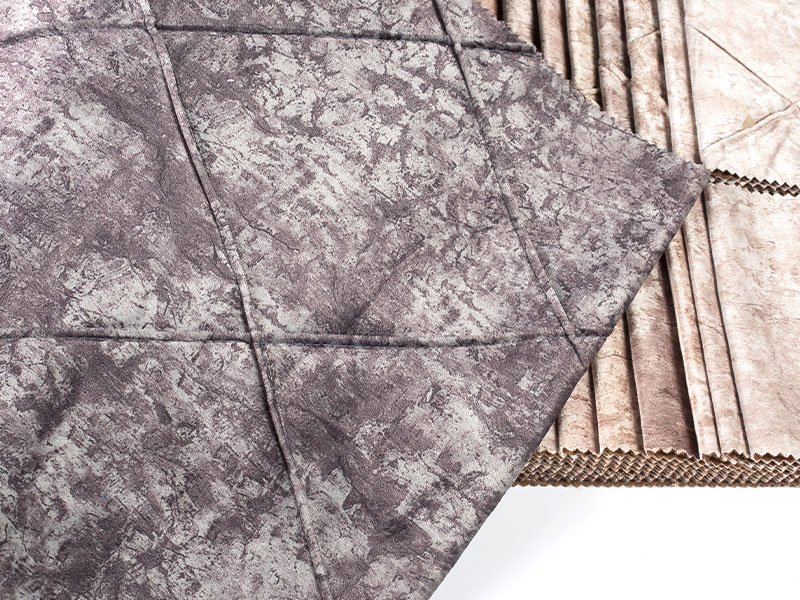Velvet quilted fabric stands as a testament to the enduring appeal of combining luxurious texture with practical design. This exquisite material, celebrated for its opulent feel and plush aesthetic, has carved a significant niche in interior design, fashion, and even specialized industrial applications. Far from being a mere decorative element, its unique construction offers a compelling blend of beauty, comfort, and durability.
Understanding the Anatomy: Velvet Meets Quilting
To truly appreciate velvet quilted fabric, it’s essential to dissect its two core components:
-
Velvet: This distinctive woven tufted fabric is characterized by a short, dense pile, giving it its signature soft, lustrous surface. Traditionally made from silk, velvet is now commonly produced using cotton, linen, wool, and synthetic fibers like rayon and polyester. The method of weaving creates tiny loops that are then cut, resulting in the characteristic pile that catches the light and offers an unparalleled tactile experience. Different types of velvet, such as crushed velvet, panne velvet, or velveteen, offer variations in pile direction and sheen, each contributing a unique character.
-
Quilting: This technique involves stitching together two or more layers of fabric, typically with a layer of padding (batting or wadding) in between. The stitching serves not only to hold the layers together but also to create decorative patterns and add dimensional texture. Common quilting patterns include diamond, channel, box, and more intricate free-motion designs.
When these two elements converge, the result is a fabric that offers the best of both worlds: the inherent elegance and softness of velvet, enhanced by the added loft, warmth, and structural integrity of quilting.
Beyond Aesthetics: The Functional Advantages
While its visual appeal is undeniable, velvet quilted fabric offers a range of practical benefits that contribute to its widespread use:
-
Enhanced Durability and Stability: The quilting process anchors the velvet face fabric to a backing, often a stable cotton or polyester, and secures the internal padding. This multi-layered construction significantly increases the fabric's durability and resistance to stretching or sagging compared to unquilted velvet. The stitching patterns also help to distribute stress, making the fabric more resilient to wear and tear.
-
Thermal Insulation: The trapped air within the batting layer provides excellent thermal insulation, making velvet quilted fabric a preferred choice for items where warmth is desired, such as winter coats, throws, and upholstered furniture in colder climates.
-
Acoustic Absorption: The plushness and multi-layered structure contribute to sound absorption, making it beneficial in spaces where reducing echo or external noise is a consideration.
-
Dimensionality and Loft: The quilting process introduces a beautiful three-dimensional quality, adding depth and visual interest that flat velvet cannot achieve. This loft contributes to a more luxurious and inviting feel.
-
Comfort: The added padding provides an extra layer of cushioning, enhancing comfort in seating, bedding, and apparel.
Applications Across Industries
The versatility of velvet quilted fabric is evident in its diverse applications:
-
Interior Design: This is perhaps its most prominent domain. From opulent headboards, sofas, and armchairs that exude grandeur, to sumptuous cushions, throws, and draperies that add a touch of sophistication, velvet quilted fabric transforms living spaces into havens of luxury. Its ability to create a focal point and add tactile richness is unparalleled.
-
Fashion and Apparel: In haute couture and ready-to-wear, velvet quilted fabric lends itself to elegant coats, jackets, vests, and even skirts and dresses. Its warmth, drape, and visual appeal make it a popular choice for statement pieces and winter collections. Accessories like handbags and footwear also benefit from its luxurious texture.
-
Bedding: Quilted velvet comforters, duvets, and shams offer both warmth and a lavish aesthetic to bedrooms, creating a truly inviting sleep environment.
-
Automotive and Marine Interiors: In high-end vehicles and yachts, quilted velvet is sometimes used for seating and interior panels, contributing to a premium and comfortable experience.
-
Specialty Items: From elegant jewelry boxes and bespoke luggage linings to theatrical costumes, velvet quilted fabric finds its way into various niche applications where a blend of luxury and padding is required.
Care and Maintenance
While durable, velvet quilted fabric requires specific care to maintain its pristine appearance. Dry cleaning is often recommended for items with significant batting or intricate construction. For minor spills, spot cleaning with a mild, pH-neutral cleaner is advisable, always testing on an inconspicuous area first. Brushing the pile gently with a soft brush can help restore its luster and remove dust. Avoiding direct sunlight and high humidity will also help preserve the fabric's integrity and color over time.
The Future of Velvet Quilted Fabric
As sustainable practices gain momentum, the future of velvet quilted fabric may see an increased use of recycled fibers for both the velvet and the batting, as well as more eco-friendly dyeing and finishing processes. Innovation in quilting techniques and patterns will also continue, offering designers and consumers an even wider array of aesthetic choices.
In conclusion, velvet quilted fabric is more than just a textile; it's a statement. Its harmonious fusion of visual splendor, tactile delight, and practical functionality ensures its continued prominence in the realm of luxury materials, promising comfort and elegance for generations to come.



 Language
Language  English
English 中文简体
中文简体 عربى
عربى





















